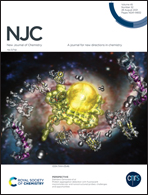Construction of a novel Cu2(OH)3F/g-C3N4 heterojunction as a high-activity Fenton-like catalyst driven by visible light†
Abstract
Inhibiting the competitive effect of O2 in copper-based Fenton reagents and improving the photogenerated electron–hole pair separation of g-C3N4 are the focus of current research. In this article, Cu2(OH)3F was successfully synthesized by the hydrothermal method and combined with g-C3N4via a simple mix-load method. The composite catalyst (CFO/CN) exhibits an excellent catalytic effect for degradation of dyes in wastewater in a photo-assisted Fenton-like system. Among the samples, CFO-40 shows the best catalytic effect, and the reaction rate is 4.67 times and 17.5 times as high as that of pure g-C3N4 and Cu2(OH)3F under the same conditions, respectively. The enhancement of the photocatalytic activity is mainly due to the formation of a photo-assisted Fenton-like effect between Cu2(OH)3F and g-C3N4, which not only accelerates the separation and transfer of photogenerated carriers, but also promotes the conversion and circulation of Cu(II) and Cu(I). In addition, it has been proved that the material has a wide pH range. The continuous degradation experiment shows that the material has superior stability and recyclability. Additionally, it is confirmed that ˙OH, O2˙−, and h+ all contribute to the reaction, among which ˙OH plays a major role. This research introduces a new member to the family of photo-assisted Fenton-like technologies.



 Please wait while we load your content...
Please wait while we load your content...